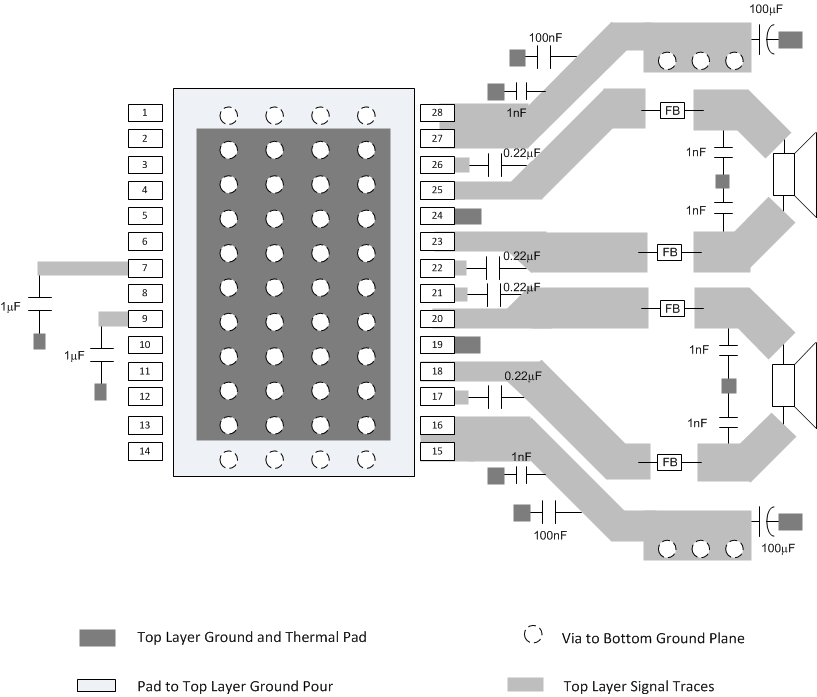SLOS650F August 2009 – June 2016 TPA3113D2
PRODUCTION DATA.
- 1 Features
- 2 Applications
- 3 Description
- 4 Revision History
- 5 Pin Configuration and Functions
-
6 Specifications
- 6.1 Absolute Maximum Ratings
- 6.2 ESD Ratings
- 6.3 Recommended Operating Conditions
- 6.4 Thermal Information
- 6.5 DC Electrical Characteristics, VCC = 24 V
- 6.6 DC Electrical Characteristics, VCC = 12 V
- 6.7 AC Electrical Characteristics, VCC = 24 V
- 6.8 AC Electrical Characteristics, VCC = 12 V
- 6.9 Typical Characteristics
- 7 Detailed Description
-
8 Application and Implementation
- 8.1 Application Information
- 8.2
Typical Applications
- 8.2.1
Stereo Class-D Amplifier With BTL Output
- 8.2.1.1 Design Requirements
- 8.2.1.2
Detailed Design Procedure
- 8.2.1.2.1 Ferrite Bead Filter Considerations
- 8.2.1.2.2 Efficiency: LC Filter Required With the Traditional Class-D Modulation Scheme
- 8.2.1.2.3 When to Use an Output Filter for EMI Suppression
- 8.2.1.2.4 Input Resistance
- 8.2.1.2.5 Input Capacitor, CI
- 8.2.1.2.6 BSN and BSP Capacitors
- 8.2.1.2.7 Differential Inputs
- 8.2.1.2.8 Using LOW-ESR Capacitors
- 8.2.1.3 Application Curves
- 8.2.2 Stereo Class-D Amplifier With BTL Output
- 8.2.3 Stereo Class-D Amplifier With PBTL Output
- 8.2.1
Stereo Class-D Amplifier With BTL Output
- 9 Power Supply Recommendations
- 10Layout
- 11Device and Documentation Support
- 12Mechanical, Packaging, and Orderable Information
Package Options
Mechanical Data (Package|Pins)
- PWP|28
Thermal pad, mechanical data (Package|Pins)
- PWP|28
Orderable Information
10 Layout
10.1 Layout Guidelines
The TPA3113D2 can be used with a small, inexpensive ferrite bead output filter for most applications. However, because the Class-D switching edges are fast, it is necessary to take care when planning the layout of the printed-circuit board. The following suggestions help to meet EMC requirements.
- Decoupling capacitors—The high-frequency decoupling capacitors must be placed as close to the PVCC and AVCC terminals as possible. Large (220 µF or greater) bulk power supply decoupling capacitors should be placed near the TPA3113D2 on the PVCCL and PVCCR supplies. Local, high-frequency bypass capacitors must be placed as close to the PVCC pins as possible. These capacitors can be connected to the thermal pad directly for an excellent ground connection. Consider adding a small, good-quality low ESR ceramic capacitor between 220 pF and 1000 pF and a larger mid-frequency cap of value between 0.1 μF and 1 μF also of good quality to the PVCC connections at each end of the chip.
- Keep the current loop from each of the outputs through the ferrite bead and the small filter cap and back to PGND as small and tight as possible. The size of this current loop determines its effectiveness as an antenna.
- Grounding—The AVCC (pin 7) decoupling capacitor must be grounded to analog ground (AGND). The PVCC decoupling capacitors should connect to PGND. Analog ground and power ground should be connected at the thermal pad, which must be used as a central ground connection or star ground for the TPA3113D2.
- Output filter—The ferrite EMI filter (Figure 35) must be placed as close to the output terminals as possible for the best EMI performance. The LC filter (Figure 33 and Figure 34) must be placed close to the outputs. The capacitors used in both the ferrite and LC filters should be grounded to power ground.
- Thermal Pad—The thermal pad must be soldered to the PCB for proper thermal performance and optimal reliability. The dimensions of the thermal pad and thermal land should be 6.46 mm by 2.35 mm. Seven rows of solid vias (three vias per row, 0,3302 mm or 13 mils diameter) must be equally spaced underneath the thermal land. The vias must connect to a solid copper plane, either on an internal layer or on the bottom layer of the PCB. The vias must be solid vias, not thermal relief or webbed vias. See the TI Application Report Quad Flatpack No-Lead Logic Packages for more information about using the TSSOP thermal pad. For recommended PCB footprints, see figures at the end of this data sheet.
For an example layout, see the TPA3113D2 EVM Audio Amplifier Evaluation Board. Both the EVM user manual and the thermal pad application report are available on the TI Web site at http://www.ti.com.
10.1.1 PCB Material Recommendation
TI recommends using FR-4 Glass Epoxy material with 1 oz. (35 μm) for the TPA3113D2. The use of this material can provide for higher power output, improved thermal performance, and better EMI margin (due to lower PCB trace inductance). TI recommends using several GND underneath the device thermal pad for thermal coupling to a bottom side copper GND plane for best thermal performance.
10.2 Layout Example
 Figure 40. BTL Layout Example
Figure 40. BTL Layout Example